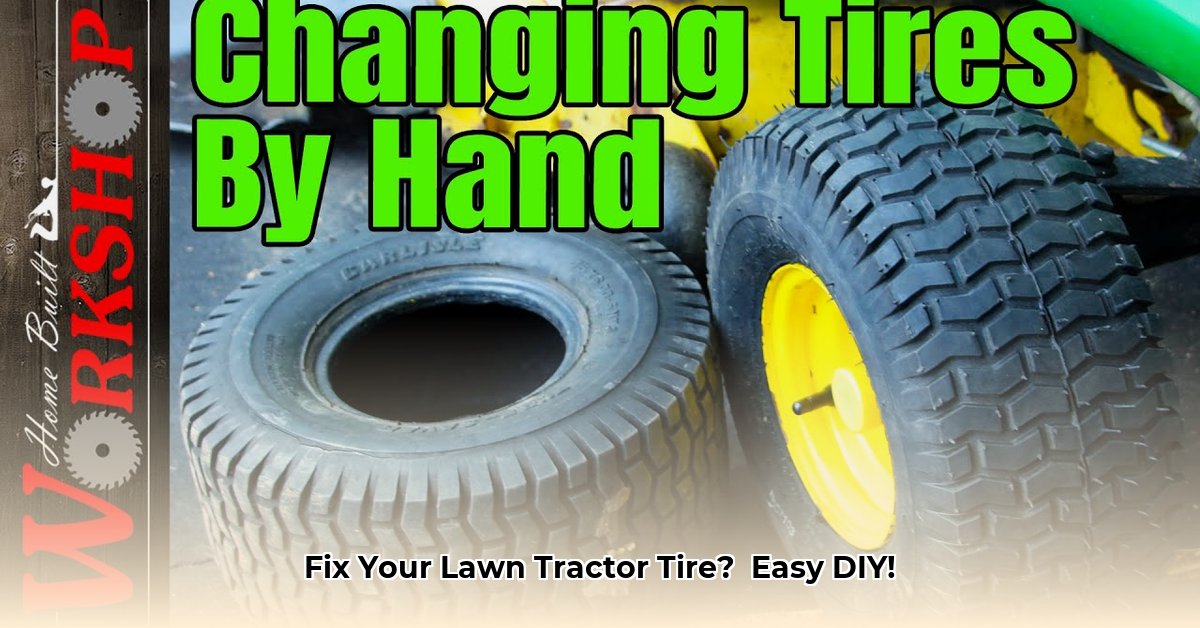
Replacing a lawn tractor tire is a straightforward DIY project that can save you money and time. This guide outlines two methods – using hand tools or power tools – providing step-by-step instructions for each. We'll cover everything from safety precautions to choosing the right approach for your skill level and resources. For more information on tire sizes, check out this helpful resource: 20x8-00-10 tractor tires.
Safety First: Protecting Yourself
Before you begin, remember safety is paramount. Working with heavy equipment and potentially sharp tools requires caution. Always wear sturdy work gloves to protect your hands. Eye protection is crucial to shield your eyes from flying debris. Most importantly, properly support your lawn tractor. Never rely solely on the jack; always use jack stands positioned securely under the frame, as shown in your owner's manual. Consult your owner’s manual for specific safety recommendations for your tractor model.
Method 1: The Hand Tool Approach
This method is ideal for those who prefer a hands-on experience and have limited tools. While it may take longer, it's entirely achievable.
- Prepare the Tractor: Turn the ignition off and remove the key. Engage the parking brake.
- Loosen the Lug Nuts: Use a wrench to slightly loosen the lug nuts on the flat tire. This prevents them from spinning when the wheel is lifted.
- Jack Up the Tractor: Carefully jack up the tractor wheel, ensuring the jack is positioned correctly under the frame. Immediately place jack stands under the frame for additional support.
- Remove the Wheel: Once securely supported, fully unscrew the lug nuts and carefully remove the wheel. Set it aside in a safe location.
- Tire Removal: Use tire irons to carefully pry the old tire off the rim. Work your way around the tire, gently prying it off section by section. This may require some effort and patience.
- New Tire Installation: Carefully position the new tire onto the rim, ensuring it's seated evenly.
- Reassembly: Remount the wheel onto the studs, tighten the lug nuts securely, and slowly lower the tractor using the jack.
- Final Check: Ensure all nuts are tightened, the wheel rotates freely, and the tire is properly inflated to the pressure specified in your owner's manual.
Pros: Requires minimal specialized tools. Provides a satisfying sense of accomplishment.
Cons: Can be physically demanding and time-consuming.
Method 2: Power Tool Efficiency
This method speeds up the process using power tools. However, extra caution is needed due to the increased power and potential for accidents.
- Prepare the Tractor: Follow steps 1 and 2 from Method 1.
- Quick Nut Loosening: Use an impact wrench to quickly loosen the lug nuts. This significantly reduces the effort required.
- Jack and Remove: Jack up the tractor (using jack stands!), and remove the wheel. The impact wrench expedites this step.
- Tire Removal & Installation: Use tire lubricant (e.g., soapy water) to help separate the tire bead from the rim and ease installation of the new tire.
- Tighten the Nuts: Use the impact wrench to tighten the lug nuts. Avoid over-tightening; consult your owner's manual for the recommended torque.
- Final Check: Lower the tractor and perform a final check to ensure everything is secure and the tire is inflated correctly.
Pros: Saves time and physical effort.
Cons: Requires specialized equipment (air compressor and impact wrench), adding to the initial cost. Requires careful attention to avoid over-tightening.
Choosing the Right Method: Hand Tools vs. Power Tools
The best method depends on your available tools, physical capabilities, and time constraints. If you own power tools and value speed and efficiency, the power tool method is ideal. If you possess only hand tools or prefer a more hands-on experience, the hand tool method is perfectly viable.
Conclusion: Get Rolling Again!
Replacing your lawn tractor tire is a manageable task for most DIY enthusiasts. Choosing the right method and prioritizing safety will ensure a successful repair. Remember to consult your owner's manual for specific instructions and safety information related to your model. Now get out there and enjoy your freshly repaired lawn tractor!